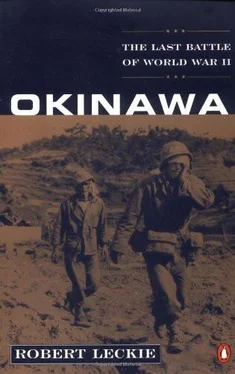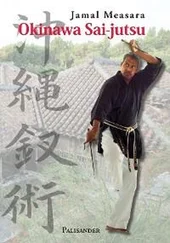Thus was the kamikaze born, in an outburst of national ecstasy and anticipated deliverance. In the homeland a huge corps of suiciders was organized under Vice Admiral Matome Ugaki. By January 1945 they were part of Japanese military strategy, if not the dominant part. So many suiciders would be ordered out on an operation, to be joined by so many first-class fighters and bombers: the fighters to clear the skies of enemy interceptors, the bombers to ravage American shipping and guide the kamikaze to their victims.
They needed to be guided because they usually were a combination of old, stripped-down aircraft and young, often hopped-up flyers. Admiral Ugaki did not use his newest planes or his most skilled pilots, as Admiral Onishi had in the Philippines. Ugaki considered this wasteful. He believed that the “spiritual power” of the “glorious, incomparable young eagles” would compensate for the missing firepower of obsolete crates from which even the instruments had been removed. At a period in the Pacific War when perceptive Japanese commanders were beginning to ridicule the “bamboo-spear tactics” of the School of Spiritual Power, as opposed to the realities of firepower, Ugaki was showering his brave young volunteers—for brave they truly were—with encomiums of praise intended to silence whatever reservations they may have had about piloting these patched-up old cripples, and also to inspire the nation.
So the suiciders were hailed as saviors: wined, dined, photographed, lionized. Many of them attended their own funerals before taking off on their last mission. Farewell feasts were held in their honor at the numerous airfields on the southernmost Japanese island of Kyushu. Solemn Samurai ceremonies were conducted, and many toasts of sake drunk, so that some of the pilots climbed aboard their airplanes on wobbly legs. It did not seem to occur to the Japanese—and especially Ugaki—that insobriety might affect the aim of the kamikaze and thus defeat the purpose of the suicide corps; and this was because the concept of the suicide-savior had so captivated the nation from schoolgirls to Emperor Hirohito himself that the slightest word of criticism would have been regarded as treason. And it was this very deep and very real faith in another coming of a Divine Wind that dictated to the planners at Imperial Headquarters exactly how the battle of Okinawa was to be fought.
The speed with which the Americans were overrunning the Philippines had produced a mood of the blackest pessimism at Imperial Headquarters in Tokyo in late 1944—until those roseate reports of kamikaze success during December and January replaced the darkest despair with the brightest hopes. By 1945 Headquarters had decided that the United States would next strike at Okinawa to seize a base for the invasion of Japan proper, as the four Home Islands were called. It was now believed that the kamikaze corps could greatly improve the chances for a successful defense of Okinawa, and thus perhaps—even probably—prevent enemy landings in the Home Islands. So a plan called Ten-Go, or “Heavenly Operation,” was devised. New armies were to be formed from a reserve of military-age men who had been deferred for essential labor, while a powerful air force built around the kamikaze would be organized to destroy the Americans.
More than four thousand airplanes, both suicide and conventional, would launch an all-out attack, joined by hundreds of suicide motorboats operating from Okinawa and the Kerama Islands and followed by a suicide dash of Japan’s remaining warships, including the mighty battleship Yamato. The air assaults would come from two directions: north from Formosa where the Japanese Army’s Eighth Air Division and the Navy’s First Air Fleet were based, and south from Kyushu, with a more powerful force combining several Army and Navy commands, all under the direction of Vice Admiral Ugaki. On February 6 a joint Army-Navy Air Agreement stated:
In general Japanese air strength will be conserved until an enemy landing is underway or within the defense sphere … Primary emphasis will be laid on the speedy activation, training and mass employment of the Special Attack Forces
(kamikaze)
… The main target of Army aircraft will be enemy transports, and of Navy aircraft carrier attack forces.
On its face this was a bold plan conceived in an atmosphere of the most cordial cooperation. Actually, the only leaders motivated by the same conviction were those who believed that the war could no longer be won. Otherwise, there was a deep divergence: the Navy officers seeing Ten-Go as the last opportunity to score a great, redeeming victory; the Army staffers in agreement that the final battle would be fought not on Okinawa but on Kyushu. Though their views conflicted, their reasoning was logical: the sailors, certain that if airpower could not stop the enemy at Okinawa, neither would it do so on Kyushu; the Army insisting that even on the Philippines the Americans had not yet fought a major Japanese army, and that, shattered and whittled by the suicide-saviors, they could be repulsed in Japan proper. However, all—even the doubters—were convinced that at the very least a severe defeat must be inflicted on the Americans to compel the Allies to modify their demand for Unconditional Surrender.
There was one more consideration, probably more apparent to the Army than the Navy. Bamboo-spear tactics were out. The illogical belief that spiritual power could conquer firepower had spawned that other cause of Japan’s absolute inability to halt the American charge across the Pacific: the doctrine of destroying the enemy invaders “at the water’s edge.” Those nocturnal, massed frontal attacks known as “Banzai charges” had repeatedly been broken in blood, leaving the Japanese defenders so weakened that they were powerless to resist. Now there was a new spirit informing the Japanese Army: defense in depth—as careful as the Banzai was reckless, as difficult for the enemy to overcome as the foolhardy wild Banzai had been easy for him to shatter, and so costly in the attrition of enemy men, machines, and ships as to weary the Americans and thus induce them to negotiate.
Ambush, or the tactics of delay raised to a military science, began on the large island of Biak off the western extremity of New Guinea. It was conceived by Colonel Kuzume Naoyuki, commander of about eleven thousand troops of the defense garrison there. Disdainful of the doctrine of destruction at the water’s edge, he decided instead to allow the Americans to come ashore unopposed so that they would stroll unwarily into the trap he would prepare for them. This would turn the area around the vital airfield there into a martial honeycomb of caves and pillboxes—all mutually supportive—filled with riflemen, automatic weapons, artillery, batteries of mortars, and light tanks. Naoyuki also stockpiled these positions with enough ammunition, food, and water—that priceless liquid was less than abundant on Biak, where the heat and humidity would take a toll equal to enemy gunfire—to sustain his defense for months. Thus, when the 162nd Infantry of the Forty-first Division of the U.S. Army landed on Biak on May 27, 1944, they did indeed move confidently inland expecting little opposition—until they reached that vital airfield. Then, from the lowlying terrain around them and the ridges above, there fell a terrible storm of shot and shell that pinned them to the ground; it was not until dark that amtracks were able to extricate them from the trap.
Thereafter, there was no foolish and furious Banzai by which the Japanese enemy customarily bled itself to death. Biak was a grinding, shot-for-shot battle. Ambush, or delay, was repeated at Peleliu and Iwo Jima, battles that the U.S. Marines expected to be won within days or a week or so but lasted for months, with staggering losses not only in valuable time but in still more valuable life and equipment.
Читать дальше










